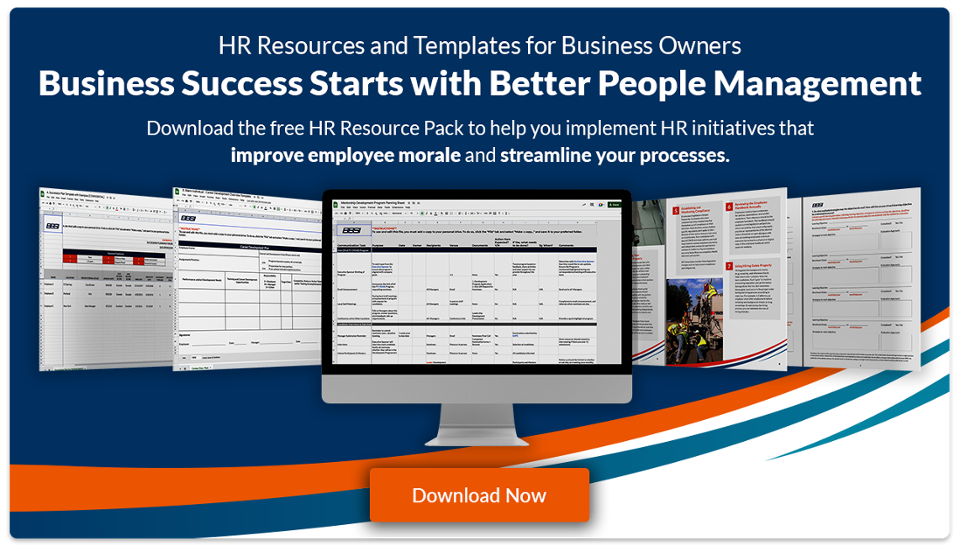
Mentorship Programs: A Small Business’ Key to Workforce Development and Employee Engagement
Expertise provided by Tangela Cuascut, BBSI HR Consultant
Many businesses have difficulty improving employee engagement and retention rates because they don't intentionally invest in career development opportunities for their employees. In fact, mentorship programs improve employee morale and reduce turnover because they show employees that management values their growth and involvement.
This is why all companies should consider setting up a mentorship program. Even small businesses can get a lot of value from matching up senior and junior members.
This article will cover the benefits of a mentorship program, the different types of mentorship programs you should consider, and what makes a mentorship program great.
What is a Mentorship Program?
A formal mentoring program is a structured process businesses can use to foster relationships between senior or high-performing employees and those with less experience. A well-functioning mentorship program directs a business to better reflect its goals and values.
Senior employees pass on existing knowledge, skills, and experience to help junior employees advance their careers. However, a mentorship program can also help senior employees and leadership learn from the fresh perspective of newer employees.
A mentorship program shouldn’t lower morale or exclude anyone who wants to participate. Anyone in any role could learn or take guidance from someone with different life experiences and challenges.
It also shouldn't seem like an opportunity only for rising stars or something that could sow jealousy among employees; it should be an inclusive opportunity everyone can take advantage of.
Why are Mentorship Programs Important?
Mentorship programs are a critical business strategy that companies should use to build a better-trained and more engaged workforce.
Mentorship programs provide employees the opportunities for upward mobility and personal growth that they have come to expect from their employers. Their relationship with senior leaders in the company also gives them a confidential place to discuss their challenges and goals, and receive guidance from experienced leaders.
By building connections between employees at different levels in the company, businesses also improve communication across their workforce. With these connections, mentors from leadership teams can get valuable input about company proceedings from mentees and use the insight to help the company grow.
Download the Mentorship Program Planning Pack
What are the Benefits of a Mentorship Program?
A mentorship program may seem like an extra meeting or an addition to the to-do list, but companies will quickly discover the value. A successful mentorship program will help companies access the following benefits.
1. Promote Diversity and Inclusion
Mentorship is the secret ingredient to solving glass ceiling issues.
Historically, leadership teams have been reticent about hiring people who look different from them, but with a mentorship program, companies can intentionally connect employees with completely different backgrounds. These connections make leadership teams eager for more diversity among their boardrooms, executives, and senior leaders.
2. Improve Employee Engagement and Retention
Mentorships foster mutually beneficial relationships within the workforce, increase employee engagement and productivity, and help retain top talent.
Mentorship opportunities show employees their company actively invests in their careers and works to forge deeper connections within its teams. The extra support and comradery drive them to engage more with their work and develop loyalty to their company.
A quick and effective way to teach new hires about the business and workforce culture is to provide a mentor during the onboarding process. This helps set the tone and weed out any potential “bad fits” before it impacts the overall culture of an organization.
3. Help with Leadership Development and Succession Planning
Mentoring and shadowing programs uncover employees' abilities and aptitudes, helping leaders identify future roles for employees and allowing mentors to focus on teaching the necessary skills for advancement.
These programs can provide organic opportunities for employees to explore different jobs within the organization, and engage in cross-training or interdepartmental training. By shadowing or being mentored by someone in a different department or role, employees can explore jobs outside of their own that they may want to pursue within the company.
4. Creates Deep Relationships Within an Organization
Mentorships build bonds between people who may have never interacted otherwise. These programs help to build intra-organizational personal relationships and facilitate a collaborative learning and knowledge-sharing environment across departments and employees.
5. Supports a Learning Culture
The mentor-mentee relationship supports a culture in which employees continuously seek, share, and apply new knowledge and skills to improve individual and organizational performance.
The mentees' access to senior leaders gives them knowledge, skills, and experience. At the same time, leaders learn that mentoring junior employees develop their leadership skills and give them an understanding of different perspectives.
Junior employees are typically more tech-savvy and less familiar with older systems, which allows them to adapt easily to new technology and ways of doing their job. This adaptability often helps teach senior leaders how to use new technology and connect it to their deep industry experience.

Types of Mentorship Programs
At the end of the day, a mentorship program is a management training program that purposefully pairs senior and junior members of the company. There are many ways to structure a program to have a strong impact on mentors and mentees. Let’s discuss a few different kinds of mentorship.
Flash Mentoring (1:1)
A flash mentoring session is a single educational meeting between a mentor and a mentee that usually lasts one or two hours. To get the most out of a flash mentoring session, mentees should let their mentors know what topic they would like to discuss in advance so they can prepare helpful information to share.
This mentorship structure is effective in situations where there is a need to delve deeply into a topic within time constraints.
Brown Bag/Workshop Mentoring
Brown bag meetings are often structured as an open forum during working hours, typically around lunch, with a preset discussion topic. These meetings tend to have a more relaxed environment, so it's normal to discuss heavier topics such as:
- Diversity, equity, and inclusion
- Pay raises and pay ranges
- How to become a better employee
- Employee relations and conflict resolution
Circling Mentoring
Circling mentorship happens when a mentee meets with several mentors across departments. This method gives mentees several different perspectives and spreads mentorship time amongst leaders. It also allows mentees to make connections with more than one mentor while participating in the program.
Shadowing
Shadowing is the act of having employees observe a leader in a department of their choice and see their day-to-day responsibilities and the intricacies of their role. This can give mentees a fresh perspective to take back to their own role or provide inspiration to explore a career path they want to pursue.
6 Steps to Create a Workplace Mentorship Program
Starting a mentorship program can seem overwhelming, but here are six steps companies can follow to help get their program off the ground.
1. Create the Framework
The first step is the planning phase, where the executives determine the framework of the program. When creating a framework, organizers should consider the following factors:
- Business Case, Goals, and Objectives: Defining the business case helps verify the program aligns with business goals and the company’s vision. For example, if the company wants to alleviate informational silos, it should focus on matching people from different departments and require sessions where individuals discuss their own methodologies.
- Participants: As previously mentioned, mentorship programs are most effective if they don't exclude anyone from the program. In order to make mentorship beneficial for all involved, companies should identify each group of participants and determine how to best meet their needs.
- Format and Technology: The framework should determine whether sessions will happen in-person or online, along with the means for communication outside of meetings and any tools participants will use.
- Duration and Matching: It's very important to establish how long the program will run and how the company will match individuals.
- Marketing the Program: Image creates desire. Creating an exciting image of the mentorship program and promoting it correctly will motivate people to register.
- Meeting Timing: Mentorship teams could meet often, like once a week or only a few times a quarter. Leaders should also discuss whether meetings should happen during work hours and how that might affect the scope of employees’ work.
- Brand Champion: The brand champion is an informal role responsible for promoting and building support for a business's brand. A brand champion is often a company’s most vocal employee who has influential power in the organization. They can promote the mentorship program publicly and communicate the workforce's opinions with executives.
- Advisory Board: A small advisory board of at least two to three people from different backgrounds can help guide the program and make it inclusive. Business leaders should ensure to mix gender, race, background, and experience on the board for diverse inputs.
2. Communicate Objectives to Eligible Participants and Get Company Buy-in
After establishing a framework, businesses should identify ways they can make the program attractive to employees. One method many companies use is making the program mandatory for leadership because their participation often encourages employees to join as well.
The brand champion can help pitch the mentorship program to individual employees, adjusting their pitch to fit the person's interests or goals. For example, if they want to learn to code, the brand champion can let them know they'll have a mentor with programming experience.
3. Gather Employee Bios
Employees should all create a short bio that includes their:
- Experience
- Likes and dislikes
- Challenges
- Strengths and weaknesses
- Areas they want to improve
This will help match mentors and mentees down the line and decide what subject matter to highlight.
4. Pilot Program
Before launching a company-wide mentorship program, companies should run a small pilot program with two or three employees and get feedback. This will give leaders the opportunity to iron out issues before the full launch.

5. Launch
Based on how long a mentorship program will run, executives should map out a timeline to determine when key activities need to happen, who is responsible for them, and the desired outcomes. After this is established, it’s time to launch the program to a wider audience. The first two weeks should look something like this:
- Week 1 – Communication and Promotion: The first week should be light to ease people into the program. A brown bag meeting on mentoring is a great inclusive option. People off-site or working from home could receive a recording or tune in live to feel included in the launch. Consider getting creative to make the first week appealing to potential participants. For example, companies could buy marketing giveaways like mugs, mousepads, or pens.
- Week 2 – Pair Mentors and Mentees: The second week should be used to pair mentors and mentees. Companies can utilize online applications that send out short surveys to match mentors and mentees, saving businesses time and resources.
6. Assess and Improve the Program Regularly
At the end of the program, all participants should fill out a quick, one-page survey about what they thought about the program. This feedback will be critical for improving the program's next iteration and may reveal valuable insights about critical topics like company culture and employee conduct, among others.
How BBSI Helps Businesses with Mentorship Programs
HR teams looking to adopt mentorship programs as a strategic tactic for onboarding, employee engagement, retention, cultural change, or leadership may find the setup process intimidating. BBSI can help.
When businesses partner with BBSI, they get paired with a dedicated local team that becomes familiar with how the company operates and its strategic goals. Our HR Consultants are eager to help small businesses achieve their goals by providing them with tools and support to plan and implement their mentorship programs.
Contact your local branch today to understand how BBSI can help you get your mentorship program started.
Disclaimer: The contents of this white-paper/blog have been prepared for educational and information purposes only. Reference to any specific product, service, or company does not constitute or imply its endorsement, recommendation, or favoring by BBSI. This white-paper/blog may include links to external websites which are owned and operated by third parties with no affiliation to BBSI. BBSI does not endorse the content or operators of any linked websites, and does not guarantee the accuracy of information on external websites, nor is it responsible for reliance on such information. The content of this white-paper/blog does not provide legal advice or legal opinions on any specific matters. Transmission of this information is not intended to create, and receipt does not constitute, a lawyer-client relationship between BBSI, the author(s), or the publishers and you. You should not act or refrain from acting on any legal matter based on the content without seeking professional counsel.
